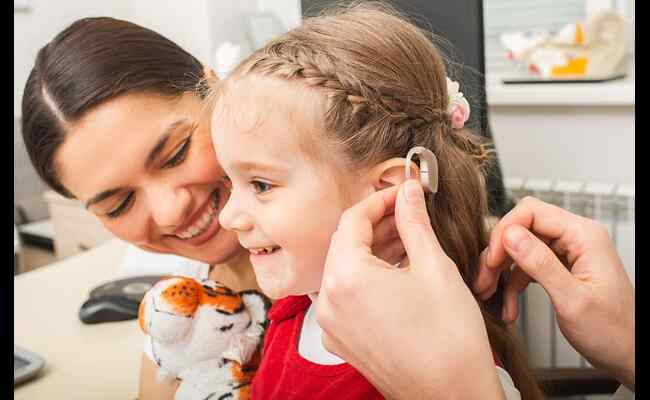Imagine a world where kids with hearing challenges can catch every giggle, whisper, or playground shout. That’s where hearing aids swoop in like tiny superheroes for little ears. In 2025, the styles of these devices have evolved into a dazzling array of options, each tailored to fit the wild, messy, wonderful lives of children. From toddlers banging on pots to school-age adventurers racing through recess, these types of aids aren’t just about sound—they’re about unlocking a kid’s universe. So, what’s the scoop on these kid-friendly wonders? Buckle up, because we’re diving into a lineup that’s as varied as a toddler’s mood swings, packed with technology that’s both mind-blowing and practical for young ears on the move.
Kicking Off with Kid-Friendly Hearing Heroes
Behind-the-Ear: The Tough Toddler Titan
Let’s kick things off with Behind-the-Ear (BTE) models, the trusty workhorses of the pediatric scene. Picture a small case chilling behind the ear, hooked up to a mold or dome that fits snugly inside. These bad boys are perfect for babies and preschoolers because they’re adjustable—growing right alongside those tiny, ever-changing ear canals. Need a quick tweak? No sweat, they’re easy to fiddle with. Plus, they’re tough enough to handle a toddler chucking them across the room. With innovations like waterproof coatings (looking at you, Phonak!), they’re built for splashy play dates. Sure, they’re not invisible, but who cares when they’re boosting speech clarity for a child still mastering “mama”?
Also Visit: How Often To Trend Cbc In Upper Gi Bleed Q6h
Receiver-in-the-Ear: Sleek and Sneaky Sound
Next up, Receiver-in-the-Ear (RITE) shakes things up a bit. Think of it as BTE’s cooler cousin—same vibe near me, but with the audio magic happening right in the canal. The device itself is slimmer behind the ear, making it a slick pick for youth who want something less bulky. It’s got that comfort factor dialed in, with durability to survive a preschool tumble. The sound zips straight to the ear, crisp and clear, which is a godsend for kids’ learning. Bonus: some come with Bluetooth, so your kid can stream tunes or class audio. Cost at places like Costco? Pretty reasonable, especially with insurance kicking in.

In-the-Ear: Full-Ear Flair for Big Kids
Now, let’s talk In-the-Ear (ITE)—the full-ear takeover. These designs plop right into the outer ear, no dangling parts. They’re a solid match for school-bound adolescents whose ears aren’t sprouting like weeds anymore. With customization options (think pink or blue shells!), they’re a hit with teens craving a bit of flair. The tech inside? Top-notch, with features like noise filters for rowdy classrooms. They’re not as tiny as some alternatives, but they pack a punch for mild loss. Price-wise, they’re mid-range—sometimes Medicaid does cover them in places like Kankakee, IL. Perfect for a learner who’s all about style and functionality.
Also Visit: Spirituality in Recovery: Optional or Beneficial?
In-the-Canal: The Subtle Sound Secret
Ever heard of In-the-Canal (ITC)? These sneaky little gadgets slide partly into the ear canal, shrinking the gear down a notch. They’re less common for infants—those canals are too small and shifty—but they shine for older minors with steady ears. The design is subtle, almost like a secret agent of listening. They’i’re great for daily chatter, but don’t expect them to wrestle with severe loss. Oticon’s got some slick variations here, with low gain settings for gentler boosts. How much are they? Depends, but financial benefits like subsidies can soften the blow. A neat pick for a kid-specific vibe.
Completely-in-Canal: The Ninja of Noise
Then there’s Completely-in-Canal (CIC), the ninja of hearing enhancements. Buried deep in the canal, these are practically invisible—a dream for self-conscious youth. But hold up—they’re tricky for babies or toddlers because tiny ears grow fast, and fitting’s a hassle. The clarity is unreal, though, like a whisper straight to the soul. They’re pricier, no lie—cost can climb past small budgets—but insurance might hook you up. Australia’s market loves them for teens with lifestyles full of sports and chatter. Just don’t expect them to handle inner nerve deafness; that’s where other solutions step in.
Also Visit: the Financial Aspects of Inpatient Rehab
Open-Fit: Breezy Boosts for Busy Ears
Open-fit Hearing Aids are the chill rebels of the bunch. A twist on BTE, they leave the canal open, letting natural noise mingle with amplified sound. Awesome for kids with mild issues, since they don’t clog up the ear. Think of it like a breeze flowing through—airy and comfy. They’re big on safety, too; no pressure buildup for growing ears. Trends on X say parents dig the lifestyle fit—perfect for active lives full of soccer and shouting. Free trials pop up sometimes, so keep an eye out. A sweet choice for listeners who hate that stuffed-up feeling.
Bone Conduction: Skull-Vibing Superstars
Last but wild, Bone Conduction Hearing Aids flip the script. Forget the ear canal—these tools send sound through the skull. Crazy, right? They’re a lifeline for children who have funky ear shapes or deaf vibes from malformations. The equipment sits on the head, vibing boosts straight to the cochlear zone. What is the primary reason fitting deaf implants skips this? It’s less invasive! Accessories like headbands make them kid-cool, and advancements keep them humming. They’re not cheap, but Medicaid can sometimes assist. A game-changer for health and social wins.
Stacking Up the Styles: Who Wins What?
So, how do these categories stack up for patients? Comparisons show BTE’s king for infant flexibility, while RITE’s got that sleek edge for preschool users. ITC and CIC lean toward adolescents who want discreet helpers, and open-fit keeps it breezy for school activities. Bone conduction? That’s the wildcard for special ear quirks. Each type brings its own performance—some with bluetooth boosters, others with durability for roughhousing. Reviews say comfort and fit trump all for young learners. What’s your kid’s vibe—rugged or refined? That’s the guide to nailing the pick.
Matching Aids to Mini Mavens
Picking the best hearing aid for children’s needs is like choosing a superpower. Development hinges on communication, so support matters big time. BTE’s got the edge for growth, but ite shines for stable ears. Cochlear implants might loom for severe cases, yet these assistive systems often do the trick cheaper. Market updates hint at small tweaks—like glue-free molds—making fits smoother. Care pros in audiology say preferences shift with age; toddlers need tough, teens crave cool. Hard of hearing? No stress—there’s a gadget for that. Which processor fits your kid’s chaos?
Counting Coins for Kiddo’s Clarity
Cost can sting, no doubt. How much are Phonak or Oticon rigs? Ballpark, a few grand—though Costco slashes price tags, and Australia’s deals are tight. Insurance or Medicaid cover varies—some families score free rides, others scrape by. Financial benefits like tax breaks help, too. Near me in Kankakee, IL, clinics hook up enhancement plans. Do work? Heck yeah—they improve speech, education, and wellness. Seniors might scoff, but kids thrive with these boosts. Adults wish they had this tech back in the day—lucky youth!
2025’s Ear Gear Final Words
Wrapping this up, 2025’s hearing aid choices for kids are a buffet of awesome. From behind–the-ear classics to bone conduction curveballs, there’s a solution for every lifestyle. Customization—think blue casings or waterproof shells—keeps lives lit. Challenges like fitting infants or funding implants linger, but innovations push past. Therapy, social skills, learning—it all clicks with the right gear. So, what’s the move? Chat with an audiology ace, weigh the benefits, and let your kid rock their acoustic world. Which style’s calling your name?
 Zulro Zulro The Info Hunter
Zulro Zulro The Info Hunter


